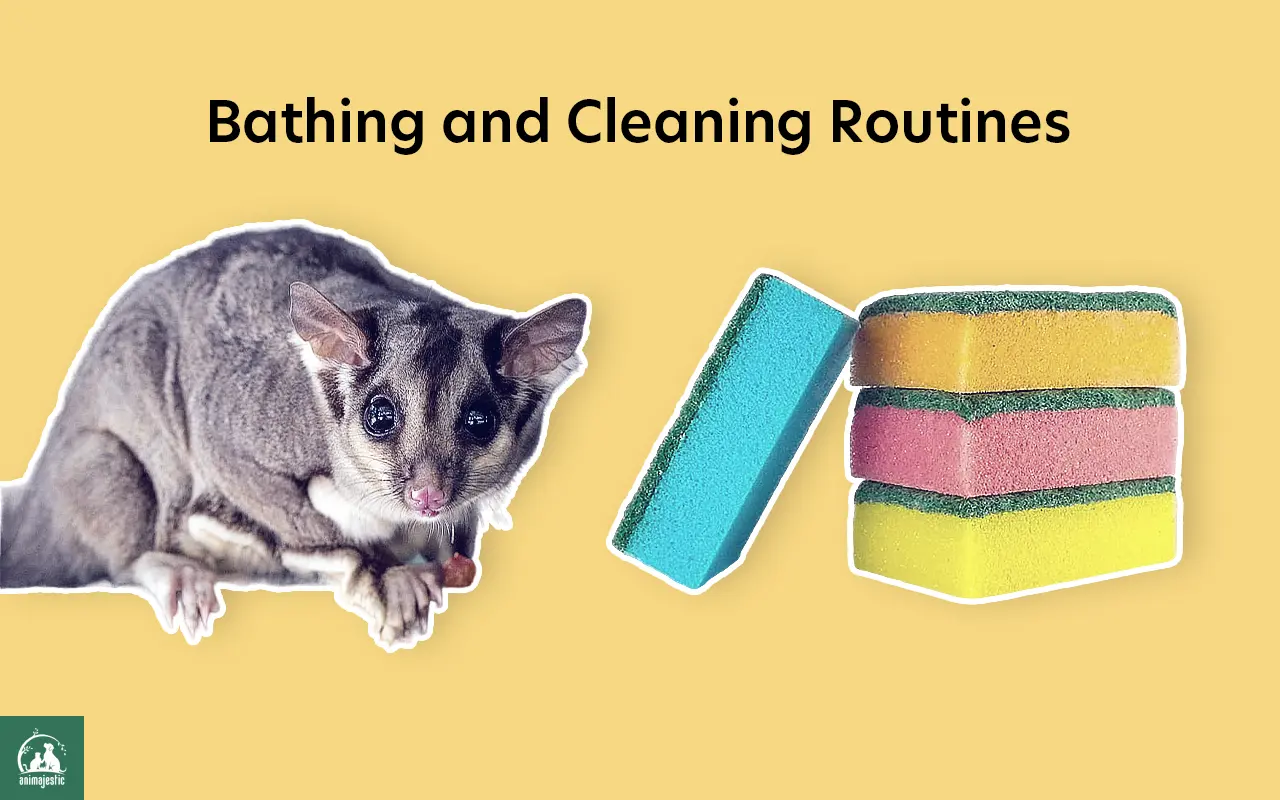Maintaining a proper bathing and cleaning routine for your sugar glider is essential for their health and well-being. Sugar gliders are naturally clean animals, and regular grooming and hygiene practices help prevent skin issues and maintain their overall cleanliness. As with any pet, proper care is essential to ensure their health and happiness.
Providing you with the knowledge needed to keep your pet in top condition is what we do at Animajestic. Here are some guidelines for bathing and cleaning routines for your sugar glider:
Bathing Your Sugar Glider
Sugar gliders are relatively low-maintenance when it comes to bathing, as they groom themselves regularly. However, there may be times when your sugar glider needs a little help with their hygiene. Here are some tips for bathing your sugar glider:
When to Bathe
- Odor: Sugar gliders have scent glands that can produce a musky odor, especially in males. If your sugar glider starts to develop an unpleasant smell, it might be time for a bath.
- Dirt or debris: If your sugar glider gets into something dirty, sticky, or greasy, you’ll need to help them clean up to prevent skin irritation or infection.
- Skin issues: If your sugar glider has a skin condition or irritation, consult your veterinarian for advice on bathing and appropriate treatment.
How to Bathe
- Prepare a warm, shallow bath: Fill a small basin or sink with warm water, making sure the water is shallow enough for your sugar glider to stand in without being submerged. You can add a few drops of a gentle, unscented pet shampoo to the water, but this is not always necessary.
- Gently lower your sugar glider into the water: Hold your sugar glider securely and gently lower them into the water, allowing them to get used to the sensation. Be patient and speak reassuringly to your pet to help them feel more comfortable.
- Use a soft cloth or sponge: Gently wipe your sugar glider with a soft cloth or sponge, avoiding their face and ears. Be especially gentle around their delicate membrane, which stretches from their wrists to their ankles and allows them to glide.
- Rinse thoroughly: Gently pour warm water over your sugar glider to rinse off any soap or debris, being careful not to get water in their ears or eyes. If you used shampoo, make sure it is completely rinsed out to avoid skin irritation.
- Dry gently: Use a soft towel to gently pat your sugar glider dry, making sure they are completely dry before returning them to their enclosure. You can also use a hairdryer on the lowest heat setting, held at a safe distance, to help speed up the drying process.
Cleaning the Enclosure
Maintaining a clean living environment for your sugar glider is crucial for their health and well-being. Here are some tips for cleaning their enclosure:
- Daily spot cleaning: Remove any uneaten food, soiled bedding, and waste from the enclosure daily. This will help prevent the growth of harmful bacteria and fungi, as well as reduce unpleasant odors.
- Weekly deep cleaning: Once a week, remove your sugar glider from their enclosure and clean all surfaces, toys, and accessories with a pet-safe disinfectant. Rinse everything thoroughly and allow it to air dry before returning your sugar glider to the enclosure. Replace the bedding with fresh material, such as paper-based bedding or fleece liners.
- Clean food and water dishes: Wash your sugar glider’s food and water dishes daily with warm, soapy water, and rinse thoroughly. This will help prevent the growth of bacteria and keep your sugar glider healthy.
- Replace toys and accessories: Regularly inspect your sugar glider’s toys and accessories for wear and tear, and replace them as needed to ensure their safety. Sugar gliders are curious and intelligent animals, so providing them with a variety of toys and enrichment items will help keep them mentally stimulated.
Grooming
Sugar gliders groom themselves naturally, but there are a few things you can do to help maintain their hygiene:
- Trim their nails: Sugar gliders have sharp nails that can become overgrown, making it difficult for them to climb and causing injury to themselves or their human caregivers. Use a small pair of pet nail trimmers to carefully trim their nails as needed, taking care not to cut the quick (the blood vessel inside the nail).
- Brush their fur: While sugar gliders groom their own fur, occasional gentle brushing with a soft-bristled brush can help remove any loose fur or debris. This can be especially helpful during shedding seasons when your sugar glider may have more loose fur than usual.
Additional Tips for Maintaining Your Sugar Glider’s Hygiene
- Monitor their diet: A healthy diet is crucial for your sugar glider’s overall health and hygiene. Feed your sugar glider a balanced diet that includes fresh fruits, vegetables, and protein sources, as well as a high-quality commercial sugar glider food. Avoid feeding them sugary treats, as these can lead to dental issues and obesity.
- Provide a clean and safe environment: Make sure your sugar glider’s enclosure is secure and free from hazards. Ensure that there are no sharp edges or small spaces where your sugar glider could become injured or trapped.
- Regular veterinary check-ups: Schedule regular check-ups with a veterinarian experienced in treating sugar gliders to monitor your pet’s health and address any issues before they become serious.
Wrap-up
Remember, each sugar glider may have different grooming needs, and it’s important to observe your glider’s behavior and health to determine the most appropriate bathing and cleaning routine. Always prioritize their safety and comfort during these processes, and seek professional advice if you have any concerns.
